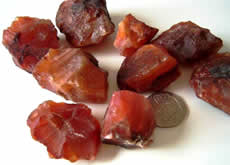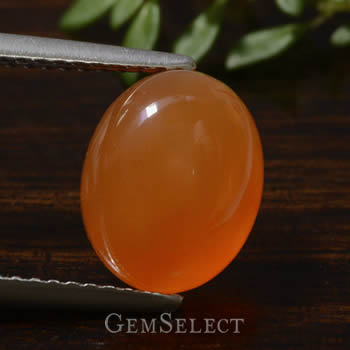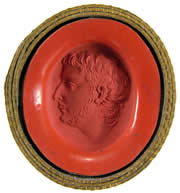Natural Carnelian Gemstones
 |
| Carnelian Rough |
Carnelian is a vibrant, orange to reddish-brown gemstone that has captivated people for centuries with its warm hues and striking appearance. A variety of chalcedony, carnelian is known for its smooth texture and rich color variations, making it a popular choice for jewelry and decorative pieces. Historically valued by ancient civilizations for its protective and healing properties, carnelian was often used in amulets and talismans. Browse our selection of carnelian for sale.
Carnelian is one of the oldest known gemstones. It was widely used in ancient Rome to make insignia and seals for imprinting on letters or important documents because hot wax does not stick to carnelian. Carnelian is one of the twelve gemstones mentioned in the Bible as appearing on the Breastplate of Aaron. It also is one of the birthstones listed in the ancient Arabic, Hebrew and Roman tables, and is a birthstone for the zodiacal sign of Virgo.

Natural Carnelian Cabochon
Like other chalcedony, carnelian has a hardness of 6.5 to 7 on the Mohs scale, and a density of 2.58 to 2.64. It has a refractive index of 1.530 to 1.540. It ranges in clarity from translucent to opaque.
Today, carnelian is used for cabochons and beads. It is also carved to produce cameos, intaglios and other sculptures. The most important carnelian deposits are found in Brazil, Uruguay, India and Madagascar.
 |
| Carnelian Cameo |
Many carnelian gemstones being offered for sale on the market today are actually agate gemstones that have been dyed and then heat-treated. But there is a way to identify natural carnelian. The dyed agate will display striping when held against the light, while the natural carnelian will show a cloudy distribution of color. Natural carnelian is becoming increasingly rare.
Since carnelian has such a long history, it is not surprising that a great deal of folkore and legend has become attached to it. Carnelian was regarded as one of the luckiest gems to wear. A proverb states that "No man who wore a carnelian was ever found in a collapsed house or beneath a fallen wall." Carnelian was used as a talisman by people dating back as early as the ancient Babylonians and Greeks. Many Muslims believe that carnelian brings peace and happiness to its owner. This belief is attributed to the fact that Mohammed wore a ring set with a carnelian seal. Emperor Napoleon jealously guarded a carnelian seal that he found in an Egyptian campaign and often wore as a watch charm.
|
